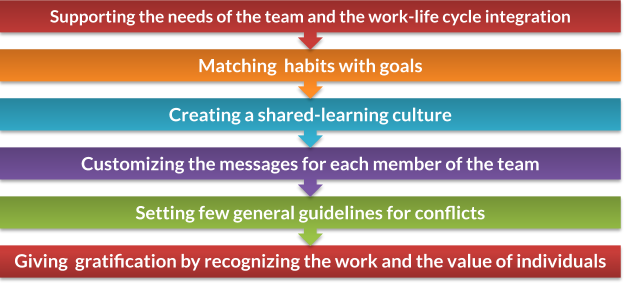Team Success: How to Connect Lonely Employees into Successful Teams?

Team success typically does not come just out of blue. It takes hard dedication and cohesive team working together as a single human to build something large. Like ants being individual cells of a structure that overcomes their size many times.
A new leader of the PR Department of a medium sized company struggled a lot to improve the relations between him and his people. The tasks were completed in time but the final products were not what everyone expected.
This PR leader arranged 3 team buildings with the hope of achieving a better coherence in the team. No results. One day he got so upset that he screamed on the phone: “Now what?! Should I know the zodiac signs of my employees?”
We’re not suggesting to find out the zodiac signs of your team but in order to create connections that can lead to a higher level of productivity and an overall team success at pretty much all the levels it is important that you engage with your team.
It’s not about doing some tasks and then ignoring each other. It’s about creating the pleasure of working with each other. The pleasure of delivering excellent products and services. Let’s not hate our job – let’s love it.
Technology and Wellbeing at the Workplace
Here at Lumeer, one thing’s for sure: we love technology. We also love to work together. The wellbeing of the team is not driven by technology itself, but by the use of tools and our cooperation when dealing with those tools.
At the beginning, the relation between technology and wellbeing at the workplace might seem a little bit complicated: we need hardware and software for our daily missions, we also need people that are eager to do their tasks.
The technology brings it’s A-Game in most of the cases. The employees have good and bad days.
The advancement in technology, products and services surpasses the advancement in creating and maintaining good social relations at the workplace. Which introduces a huge risk.
In other words, the outcome gets essential, the outcome without looking at the costs. If people in teams are not evolving alongside with the products themselves and are not enjoying their time spent in the company, they will not add value, they will simply hate their work.

Why Better Connections at the Workplace Matter
Better connections at the workplace are the vessels that carry the precious water for the whole land (including team success). Without these vessels the dynamics of teams and tasks is reduced, causing a decline in ideas, skills and money.
We have selected a few strategies for enhancing the connections at the workplace, strategies proposed by Dan Schawbel in his book, Back to human: How Great Leaders Create Connection in the Age of Isolation.
Not only the managers but also the individuals that struggle to find a meaning in their teams can apply these strategies, if their companies allow them to explore and to improve.

Supporting the Needs of the People from the Team Success
Find the general needs of the people from the team, needs which influence their behavior and productivity at work:
- the equipment for the desk,
- the applications for daily use,
- the available breaks,
- and the schedules.
Think how these elements can be improved, little by little, without huge costs. Besides this, even simple needs, like taking a break for getting the kids from school could improve the life of an employee and obtain his or her engagement for raising the overall productivity.
Also look at some duties that are out of fashion. For example, a member of the team has to create a report at the end of the week and send it through email to his boss.
Instead of wasting time creating a report, why not do it automatically with a project management software like Lumeer? Few charts with all the schedules and the results for one week so that the manager can visualize the entire progress towards team success.

Supporting the work-life cycle
Unlike computers and machines, employees do have families and social obligations, that is why supporting the balance between work and private life is a stepping stone for better connections in the company.
Delivering products and services at a higher quality is one goal. However, delivering a good schedule for most of the employees can be a huge burden, especially for the beginners and young managers:
- Set proper deadlines: We can’t expect to finish a complicated task in one day, other things which are far more simpler, can be finished in one day.
- Set realistic milestones: For example, this semester we focus on selling our product to the most important NGOs in the field of media and digital literacy.
- Set flexible free days: Apart from normal free days, there are obstacles and challenges that appear out of blue. One day off doesn’t destroy a company.
- Set a culture of balance: We do make profit by investing in both our infrastructure and our employees in a great balance. Nevertheless, failures at work shouldn’t affect the personal life much and vice versa. As we say here at Lumeer – opportunities never take a week off.
Matching habits with goals
Knowing your team is a good thing but using that knowledge for the development of the company is a total different aspect.
A quick example to clarify the situation: a goal for this month is to put together a creative ad for the winter sales. We have a teammate that does online shopping with his kids in the holiday season to avoid the time spent in shops. Why not allow them to give insights from the perspective of a client? Or even cooperate with the web team on the design of another button for the website in order to attract more potential customers?
We also know that one teammate is in love with Christmas commercials. So why not let them provide this experience and knowledge of the best elements that define a wonderful ad?
Matching habits with goals is an extraordinary way to connect with the team by showcasing how familiar things can actually be helpful at the workplace. Wouldn’t it be amazing to transform the usual skills and habits of employees into a new channel of growth for the company?
Inviting the team to a shared-learning culture
A strong connection within the team is the perfect soil for increasing the engagement and productivity of the individuals. Thus, creating a shared-learning culture.
A very busy CEO can ask us: “Wait, what this element has to do with me and my team? We’re here to make money, not to design theories!”
You’re right, but we’re talking about learning as a social and general tool. Take a look at the following examples:
- A team member learns to use a survey platform.
- A member of the team learns to use flyers in their interaction with the clients at a business meeting.
- A team member learns how to place products in a showroom for attracting the future clients.
And when these people learn from each other, that is the time when they embrace a shared-learning culture. The evolution of technology made us highschoolers again, the innovations are forcing us to learn in order to stay alive and to move forward – move towards team success.
But this time we cannot skip the classes, it is in our best interest to learn new things.
Tailoring the message as a manager
Generally, leaders have the ability to talk to the point, and to speak our minds. If a manager of a team/department reads this article, we advise them to be confident and to choose the best wording and the best way to deliver their message depending on the target audience.
Our roles in society multiplied alongside with the new digital identities. Our role in the company extends beyond the general duties.
We must personalize our discourse, different messages work for different people and different processes. A leader has to customize the messages in order to obtain more engagement from its people.
Customize even inside the team? Yes, because human beings react differently to the same words. Just like creating a code: a certain input gives a certain output.
Tailoring a message from an optimistic perspective enhances the motivation for doing a particular task. Flexible talk is a key for connecting employees to your own internet of ideas.
Setting the Guidelines for Conflicts
Nothing breaks a good connection inside a team like a conflict; however, whether you are a leader or a worker, you should know by now that conflicts come and go.
Sometimes, it is better to let them disappear on their own, sometimes we have to solve them. When a conflict requires a man-made solution, the conflict guidelines can become the bridges for getting to the solution we want.
Like wars, markets and companies are disconnected when huge conflicts appear. Conflicts threaten the profit itself. A solution might be to set some general guidelines.
It is more wise to be prepared a little than to not be prepared at all. Of course, companies cannot forecast all the conflicts, they are not think-tanks. But they can create a general guide for different challenging situations.
In the end, solving a conflict and achieving great results unites the entire team. It makes the team more confident. And confident teams are crucial for team success and overall company success.
Giving Instant Gratification in the Recognition Style
Back in the days, employees were forced to do their jobs without questioning or improving the environment. Now, it is in the interest of the leader to have a strong and vocal team in order to get more customers and more money.
Gratification is an instrument for people, if you run a team, don’t be afraid to use it. Instant gratification is not like the one from social media.
It is a recognition and feedback in a single pack. It is a “thank you” for the involvement of the participants. Gratification allows the members to fuel their motivation engines.

We tend to do those things that are highly appreciated by others, as psychological studies have shown, that is why we should give and receive (instant) gratification whenever it’s possible.
That simple act of being grateful can fuel the future of the company without even realizing it. Connections are great, but words can be magic.
From Lonely Employees to Team Success
Getting insights, knowledge and feedback from the teams allow their leaders to improve the working environment, the productivity and the energy of people. Thus increasing the level of profit.
Lumeer can help your team by letting you have a 360° view on the current tasks, milestones and deadlines as well as feedback from all the participants. Drive connected and drive connections, they will prepare the ground for team success.
